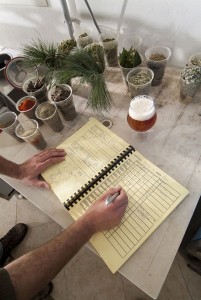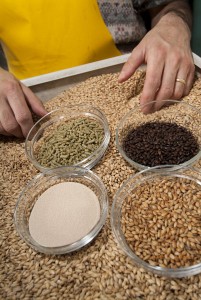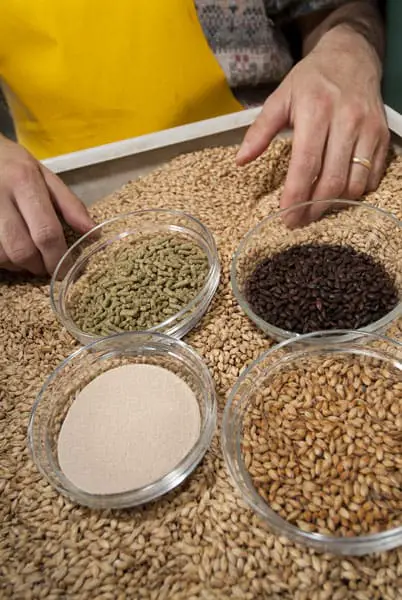
When I first started out brewing I didn’t know a Brew kettle from a fermentation bucket. So I began like most do with an extract beer kit. The beers were turning out good and the instructions in the kit were very helpful in brewing my first beers. But the kits never really seemed to hit the mark and I always made me think of things things like “if I added a little of this” or “I wish this tasted a little more like that”. So I ventured away from the pre-made kits and their recipes and started making my own. I would still recommend starting with a few kit beers to get your brewing legs before moving on to your own recipes or even adding ingredients to a kit that you buy.
It is really not too difficult to make an extract brewing recipe. You have brewed kits before so you know what goes into them. You just have to decide how much of what you want add, and when you want add it. I usually search the web for several recipes of the style of beer that I want to make and pick and choose whatever ingredients sound best out of the lot.
But in general you just need to make a few decisions. What style do you want it to be, what kind of hop flavor you would like to get out of the beer, and what strength or alcohol content the beer should be.
Decide What Type of Beer You Want To Make
When you have decide on a style, Google it. You will find many definitions on the color flavor and types of ingredients used. This will decide what type of DME/LME or Dry Malt Extract/Liquid Malt Extract you will use. If it’s a light, dark or medium bodied beer use the corresponding light, dark or medium extract. Liquid or dry doesn’t matter, it’s really whichever one you prefer to use. If you don’t know which one you like, try them both and decide for yourself. Your color won’t come from the Extract as much as it will from the specialty grains. But most of the body and flavor of the beer will. The more extract you add the stronger (or higher alcohol) your beer will be and the heavier body it will have. To give you a range a lighter beer will have around 4-5 pounds of extract and a stronger beer will have 7-8 pounds or sometimes more extract.
Choose Your Grains
 If you are making a darker beer, use darker specialty grains and so on. You can get creative here and add in chocolate roasted grains, rye grains, or many other great flavors to your beer depending on the style and flavor profile you are trying to make. Some grains will give you reddish color and some will give you deep browns. Some brew stores even let you taste a small grain sample to taste what flavors the grain can impart on your beer. Usually anywhere from 2-4 pounds of specialty grains are used but that is what’s great, it’s your recipe you can put as much as you like. The more you use to more you flavors and color you will add.
If you are making a darker beer, use darker specialty grains and so on. You can get creative here and add in chocolate roasted grains, rye grains, or many other great flavors to your beer depending on the style and flavor profile you are trying to make. Some grains will give you reddish color and some will give you deep browns. Some brew stores even let you taste a small grain sample to taste what flavors the grain can impart on your beer. Usually anywhere from 2-4 pounds of specialty grains are used but that is what’s great, it’s your recipe you can put as much as you like. The more you use to more you flavors and color you will add.
Choose Your Hops
The next main player in your beer recipe is the hops. You will need to decide how much hops to use and when to add them into the boil. Remember the longer the hop boils the more bitterness you will get from a hop. In general for bitterness boil for 50-60 minutes, for flavor with less bitter boil for 20-40 minutes, and for aroma alone boil for 15 minutes or less. So a mildly hoppy beer like a lager will require 1 maybe 2 ounces of hops added in the boil. A beer like an IPA can use as much as 4-6 ounces of hops some at the beginning, some in the middle, and some at the end of the boil. Also the more alpha acids in a hop means it has much more potential to make a beer bitter. Keep that in mind because if you use a 1 ounce of a hop with very few alpha acids (2-4) in place of one with very high alpha acids (10-15) you might not get the desired hop flavor using the same amount of hops.
Choose Your Yeast
The last big decision you will need to make is what yeast you would like to use. Again, it is very simple to search your beer style and what yeast to use with it. You will find several yeasts that are commonly accepted for that beer style. But feel free to look at all kinds of yeasts and what people are saying about them. Yeast won’t turn an English Ale into an Irish stout but using Irish stout yeast in an English Ale could provide some new valuable flavors that you might not get or that are different from an Ale yeast. If you are going for a clearer beer make sure the yeast has a high Flocculation number, Or the ability to clump up and drop out of your beer.
Specialty Ingredients
There are other special ingredients like fruit, clarifiers, oak chips and many more you can experiment with. But the malt extract, grains, hops and yeast are the basis of your beer. You can use the same directions from a brew kit to brew all of your own recipes by just substituting in your own hop addition times and maybe changing the temperature or duration of the specialty grain steep. You can also do longer boils shorter boils but the framework of the brew stills remains the same once you understand it. All extract beers are brewed almost entirely the same way with minor variations and different ingredients.
Have Fun
The point to making your own recipe is to put you in the driver’s seat. To allow you to experiment and structure a beer around what you think your beer should taste like. The more you make your own recipes and experiment with new flavors, the better brewer you will become and the better beer you will make. I don’t mean to put negative connotations on beer recipe kits. They are a lot of good beers that people have made, loved, and wanted to share with the world. But these people are not you, and everyone’s tastes are different. So go out and try to make the beer you like and have fun doing it.

